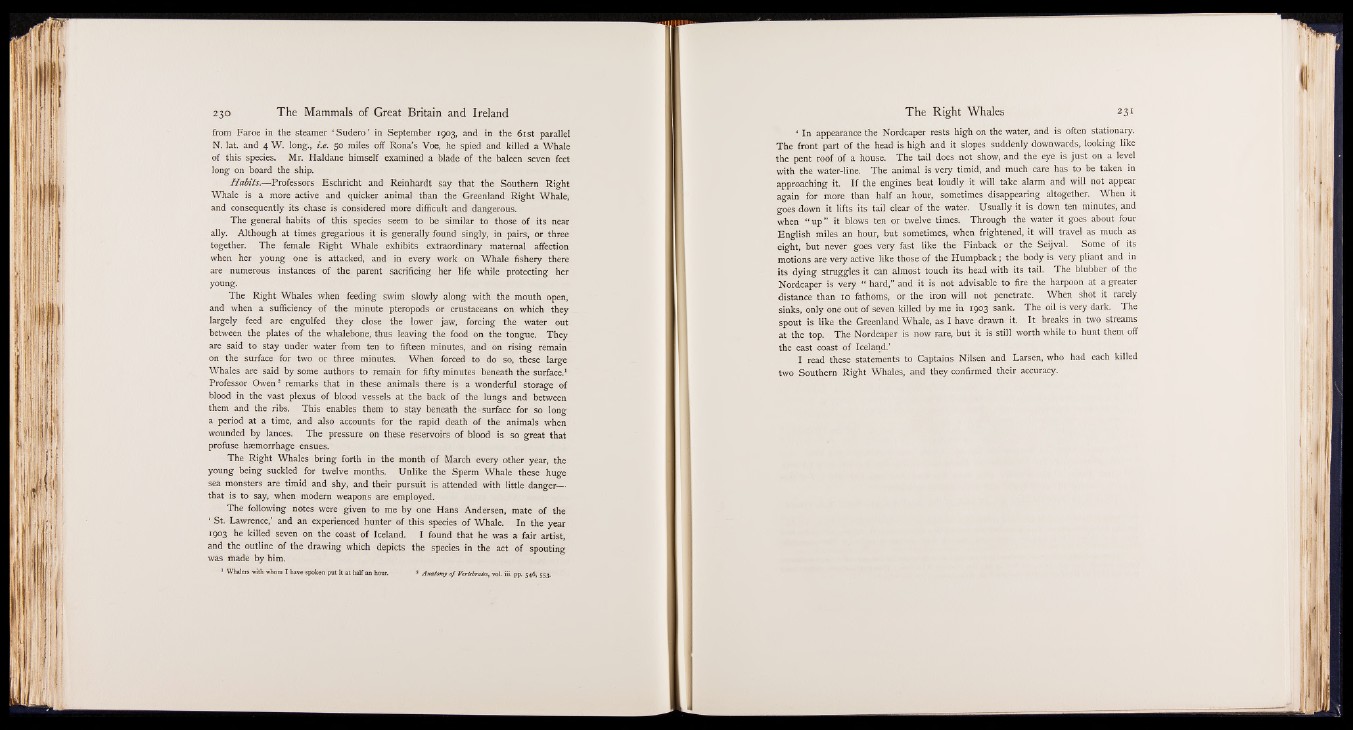
from Faroe in the steamer ‘ Sudero’ in September 1903, and in the 61st parallel
N. lat. and 4 W. long., i.e. 50 miles off Rona’s Voe, he spied and killed a Whale
of this species. Mr. Haldane himself examined a blade of the baleen seven feet
long on board the ship.
H cz&V.y;r—-Professors Eschricht and Reinhardt say that the Southern Right
Whale is a more active and quicker animal than the Greenland Right Whale,
and consequently its chase is considered more difficult and dangerous.
The general habits of this species seem to be similar to those of its near
ally. Although at times gregarious it is generally found singly, in pairs, or three
together. The female Right Whale exhibits extraordinary maternal affection
when her young one is attacked, and in every work on Whale fishery there
are numerous instances of the parent sacrificing her life while protecting her
young.
The Right Whales when feeding swim slowly along with the mouth open,
and when a sufficiency of the minute pteropods or crustaceans on which they
largely feed are engulfed they close the lower jaw, forcing the water out
between the plates of the whalebone, thus leaving the food on the tongue. They
are said to stay under water from ten to fifteen minutes, and on rising remain
on the surface for two or three minutes. When forced to do so, these large
Whales are said by some authors to remain for fifty minutes beneath the surface.1
Professor Owen2 remarks that in these animals there is a wonderful storage of
blood in the vast plexus of blood vessels at the back of the lungs and between
them and the ribs. This enables them to stay beneath the surface for so long
a period at a time, and also accounts for the rapid death of the animals when
wounded by lances. The pressure on these reservoirs of blood is so great that
profuse haemorrhage ensues.
The Right Whales bring forth in the month of March every other year, the
young being suckled for twelve months. Unlike the Sperm Whale these huge
sea monsters are timid and shy, and their pursuit is attended with little danger—
that is to say, when modern weapons are employed.
The following notes were given to me by one Hans Andersen, mate of the
‘ St. Lawrence,’ and an experienced hunter of this species of Whale. In the year
1903 he killed seven on the coast of Iceland. I found that he was a fair artist,
and the outline of the drawing which depicts the species in the act of spouting
was made by him.
1 Whalers with whom I have spoken put it at half an hour. 3 Anatomy o f Vertebrates, vol. iii. pp. 546; 553.
' In appearance the Nordcaper rests high on the water, and is often stationary.
The front part of the head is high and it slopes suddenly downwards, looking like
the pent roof of a house. The tail does not show, and the eye is just on a level
with the water-line. The animal is very timid, and much care has to be taken in
approaching it. I f the engines beat loudly it will take alarm and will not appear
again for more than half an hour, sometimes disappearing altogether. When it
goes down it lifts its tail clear of the water. Usually i t f l j down ten minutes, and
when “ up” it blows ten or twelve times. Through the water it goes about four
English miles an hour, but sometimes, when frightened, it will travel as much as
eight, but never goes very fast like thé Finback or the Seijval. Some of its
motions are very active like those of the Humpback j the body is very pliant and in
its dying struggles it can almost touch its head with its tail. The blubber of the
Nordcaper is very “ hard,” and it is not advisable to fire the harpoon at a greater
distance than io fathoms, or the iron will not penetrate. When shot it rarely
sinks, only one out of seven killed by me in 1903 sank. The oil is very dark. The
spout is like the Greenland Whale, as I have drawn it. It breaks in two streams
at the top. The Nordcaper is now rare, but it is still worth while to hunt them off
the east coast of Iceland.’
I read these statements to Captains Nilsen and Larsen, who had each killed
two Southern Right Whales, and they confirmed their accuracy.